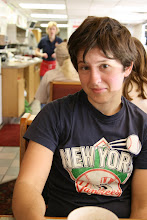 Last week after dinner with new friends Emily and Kendra I was talking about my recent epiphanies about storytelling and the project I'm working on. Kendra told me about how once she was in the middle of telling a personal story to a group of people when one of her friends interrupted and informed Kendra that the story had actually happened to her (the friend). I hadn't thought of that scenario and what it would feel like for me to hear someone tell one of my stories. It most certainly would feel stolen, and I'd probably feel pretty bummed, especially if it was a good/important one. It's romantic to feel like all my experiences are innately unique and and that they belong to me.
Last week after dinner with new friends Emily and Kendra I was talking about my recent epiphanies about storytelling and the project I'm working on. Kendra told me about how once she was in the middle of telling a personal story to a group of people when one of her friends interrupted and informed Kendra that the story had actually happened to her (the friend). I hadn't thought of that scenario and what it would feel like for me to hear someone tell one of my stories. It most certainly would feel stolen, and I'd probably feel pretty bummed, especially if it was a good/important one. It's romantic to feel like all my experiences are innately unique and and that they belong to me.I think that this is a tricky balance to consider-- to make sure that when I'm telling stories I'm not appropriating them greedily. I think that this can be avoided by really considering the emotions and details of the story, consuming them completely, ruminating over them, and then creating something new from them. I think there will always be problems for authors figuring out what it means to be an author. Last week in Art History we talked about whether it could ever be possible for a person to make art about an identity that is not their own-- for example, could a white man make art like Kara Walkers and it still mean the same thing?
I used to ask my tours similar questions back when I was working at the Boston Museum of Fine Arts. I would invite visitors to guess the gender of the artist for a selected piece. I'd say that generally if something was pastel-colored, textile or a small drawing it was assumed to be made by a woman, if it was a female nude, made of metal or a large painting it was assumed to be made by a man. We'd analyze the piece assuming that the guessed gender was correct, totally picking it apart. Then I would tell them that the piece was made by an artist of the opposite gender from what they had guessed (which meant that sometimes I lied-- but, whatever), and we would reconsider the piece with a new gendered lens. And then finally I would confirm whatever 'the truth' was, some people would always gasp in shock, some would just sort of tilt their heads and look at it one more time saying nothing, and then we would move on to something else. It was an interesting exercise because it opened up the can of what a woman could make vs. what a man could, showed that artists of either gender are equally bodied and talented, but most importantly, that the interpretation of a piece changed so wildly when considered made by one gender vs. another.
I read in a book called Memory and the Museum that the things people remember about what they see in a museum is not what's on the label, it's the personal reference that was drawn up from seeing it. For example, the the photograph resembled someones aunt, that a sculpture was ugly because of it being a color that the viewer hated, that a certain painting would look just fabulous over the viewers dining room table, etc.. I have a big critique this week for Dialogues and Practices this week and think that I will read my artist statement and then just ask my peers to tell me what they gravitate towards and why. Of course, my own stories are the propeller behind why I make my drawings, but I wont always be around, and it is my greatest hope that the images I'm making are vulnerable and accessible enough for people to look at them and get something out of them without having heard me say a word.
And of course, this necessary procedure of taking a story, making it your own, and then giving it to someone else is exactly the same procedure I'm replicating by taking an object, straying from its particularities by drawings and abstracting it and then showing it to someone else to see what they make of it. Just as I look at objects for clues of previous ownership, people will look at my drawings and make conclusions about me. I think that even if I am making a drawing from someone elses objects or stories, that by the time someone else is looking at my drawing of it, it will have become something else. So I think the answer to the question is no, a white man can not make a Kara Walker piece, a white man can make a piece that looks like a Kara Walker piece but is ultimately a white man piece. Amen.

No comments:
Post a Comment